Study on Supply–Demand Balance Analysis and Service Flow of Water Resources in Dongjiang River Basin
Abstract
:1. Introduction
2. Materials and Methods
2.1. Study Area and Basic Data
2.2. Water Supply Model
2.2.1. Water Supply Calculation
2.2.2. Model Calibration
2.3. Water Demand Model
2.4. Water Supply and Demand Balance and Spatial Flow
3. Results
3.1. Analysis of Spatial and Temporal Changes in Water Supply and Demand
3.2. Analysis of Spatial and Temporal Changes in the Balance of Water Supply and Demand
3.3. Water Resources Spatial Flow Simulation and Service Space Definition
4. Discussion
5. Conclusions
Author Contributions
Funding
Institutional Review Board Statement
Data Availability Statement
Conflicts of Interest
References
- Zhan, T.; Yu, Y.; Wu, X. Supply-Demand Spatial Matching of Ecosystem Services in the Huangshui River Basin. Ecol. Sin. 2021, 41, 7260–7272. [Google Scholar]
- Bryan, B.; Ye, Y.; Zhang, J.; Conor, J. Land-Use Change Impacts on Ecosystem Services Value: Incorporating the Scarcity Effects of Supply and Demand Dynamics. Ecosyst. Serv. 2018, 32, 144–157. [Google Scholar] [CrossRef]
- Meng, Q.; Zhang, L.; Wei, H.; Cai, E.; Dong, X. Spatio-Temporal Evolution of the Supply and Demand Risk of Ecosystem Services in the Yihe River Basin Based on Lucc. Acta Ecol. Sin. 2022, 42, 2033–2049. [Google Scholar]
- Liu, H.; Liu, L.; Ren, J.; Bian, Z.; Ding, S. Progress of Quantitative Analysis of Ecosystem Service Flow. Chin. J. Appl. Ecol. 2017, 28, 2723–2730. [Google Scholar]
- Koellnera, T.; Bonnb, A.; Arnholda, S.; Bagstade, K.; Fridmanf, D.; Guerrag, C.; Kastnerh, T.; Kissingerf, M.; Kleemannb, J.; Kuhlickei, C.; et al. Guidance for Assessing Interregional Ecosystem Service Flows. Ecol. Indic. 2019, 105, 92–106. [Google Scholar] [CrossRef]
- Gao, X.; Huang, B.; Hou, Y.; Xu, W.; Zheng, H.; Ma, D.; Ouyang, Z. Using Ecosystem Service Flows to Inform Ecological Compensation: Theory & Application. Int. J. Environ. Res. Public Health 2020, 17, 16. [Google Scholar]
- Bagstad, K.J.; Johnson, G.W.; Voigt, B.; Villa, F. Spatial Dynamics of Ecosystem Service Flows: A Comprehensive Approach to Quantifying Actual Services. Ecosyst. Serv. 2013, 4, 117–125. [Google Scholar] [CrossRef]
- Bagstad, K.J.; Villa, F.; Batker, D.; Harrison-Cox, J.; Voigt, B.; Johnson, G.W. From Theoretical to Actual Ecosystem Services: Mapping Beneficiaries and Spatial Flows in Ecosystem Service Assessments. Ecol. Soc. 2014, 19, 14. [Google Scholar] [CrossRef] [Green Version]
- Li, T.; Li, J.; Wang, Y.; Zeng, L. The Spatial Flow and Pattern Optimization of Carbon Sequestration Ecosystem Service in Guanzhong-Tianshui Economic Region. Sci. Agric. Sin. 2017, 50, 3953–3969. [Google Scholar]
- Zhang, X.; Wang, X.; Cheng, C.; Liu, S.; Zhou, C. Ecosystem Service Flows in Karst Area of China Based on the Relationship between Supply and Demand. Acta Ecol. Sin. 2021, 41, 3368–3380. [Google Scholar]
- Dun, Y.; Yang, C.; Yan, X.; Yang, Y.; Xiao, F.; Liang, S. Review of Researches on Watershed Ecosystem Services River Basin Hengduan Mountain Region. Ecol. Econ. 2019, 35, 179–183. [Google Scholar]
- Wu, R.; Liu, G.; Wen, Y. Spatiotemporal Variations of Water Yield and Water Quality Purification Service Functions in Guanting Reservoir Basin Based on Invest Model. Res. Environ. Sci. 2017, 30, 406–414. [Google Scholar]
- Dai, E.; Wang, Y. Spatial Heterogeneity and Driving Mechanisms of Water Yield Service in the Hengduan Mountain Region. Acta Geogr. Sin. 2020, 75, 607–619. [Google Scholar]
- Liu, J.; Zheng, X.; Fan, J.; Zhao, L. Evaluation of the Value of Water Retention Service in the Middle and Upper Reaches of Hunhe River Based on Swat Model. Chin. J. Appl. Ecol. 2021, 32, 3905–3912. [Google Scholar]
- Tian, F.; Lü, Y.H.; Fu, B.; Yang, Y.; Qiu, G.; Zang, C.; Zhang, L. Effects of Ecological Engineering on Water Balance under Two Different Vegetation Scenarios in the Qilian Mountain, Northwestern China. J. Hydrol. Reg. Stud. 2016, 5, 324–335. [Google Scholar] [CrossRef] [Green Version]
- Tao, Y.; Wang, H.; Ou, W.; Guo, J. A Land-Cover-Based Approach to Assessing Ecosystem Services Supply and Demand Dynamics in the Rapidly Urbanizing Yangtze River Delta Region. Land Use Policy 2018, 72, 250–258. [Google Scholar] [CrossRef]
- Serna-Chavez, H.M.; Schulp, C.J.E.; van Bodegom, P.M.; Bouten, W.; Verburg, P.H.; Davidson, M.D. A Quantitative Framework for Assessing Spatial Flows of Ecosystem Services. Ecol. Indic. 2014, 39, 24–33. [Google Scholar] [CrossRef] [Green Version]
- Vrebos, D.; Staes, J.; Vandenbroucke, T.; D’Haeyer, T.; Johnston, R.; Muhumuza, M.; Kasabeke, C.; Meire, P. Mapping Ecosystem Service Flows with Land Cover Scoring Maps for Data-Scarce Regions. Ecosyst. Serv. 2015, 13, 28–40. [Google Scholar] [CrossRef]
- Li, D.; Wu, S.; Liu, L.; Liang, Z.; Li, S. Evaluating Regional Water Security through a Freshwater Ecosystem Service Flow Model: A Case Study in Beijing-Tianjian-Hebei Region, China. Ecol. Indic. 2017, 81, 159–170. [Google Scholar] [CrossRef]
- Zhang, S.; Meng, X.; Liao, Q. Research on Water Resources and Water Balance in Beijing Processes in an Urbanized Basin. Geogr. Res. 2012, 31, 1991–1997. [Google Scholar]
- Chen, D.; Li, J.; Zhang, Y.; Zhang, C. Quantification and Simulation of Supply, Demand and Flow of Water Provision Service in the Yanhe Watershed, China. Acta Ecol. Sin. 2020, 40, 112–122. [Google Scholar]
- Ren, M.; Mao, D. Supply and Demand Analysis and Service Flow Research of Water Production Service in Lianshui River Basin. Ecol. Sci. 2021, 40, 186–195. [Google Scholar]
- Meng, X.; Wang, H.; Chen, J. Profound Impacts of the China Meteorological Assimilation Driving Datasets for the Swat Model (CMADS). Water 2019, 11, 832. [Google Scholar] [CrossRef] [Green Version]
- Wang, Y.; Lü, H.; Jiang, T. Influence of Watershed Subdivision and Dem Resolution on Swat Runoff Simulation. J. China Hydrol. 2008, 3, 22–25. [Google Scholar] [CrossRef]
- Wang, Z.; Liu, C.; Huang, Y. The Theory of Swat Model and Its Application in Heihe Basin. Prog. Geogr. 2003, 1, 79–86. [Google Scholar] [CrossRef]
- Yang, G.; Hao, F.; Liu, C.; Zhang, X. The Study on Baseflow Estimation and Assessment in Swat—Luohe Basin as an Example. Prog. Geogr. 2003, 5, 463–471. [Google Scholar] [CrossRef]
- Zuo, D.; Xu, Z. Distributed Hydrological Simulation Using Swat and Sufi-12 in the Wei River Bsain. J. Beijing Norm. Univ. (Nat. Sci.) 2012, 48, 490–496. [Google Scholar]
- Qian, K.; Ye, S.; Zhu, Q. Evapotranspiration Simulation with Different Scenarios Analysises of Fangshan District by Swat Model. Trans. Chin. Soc. Agric. Eng. 2011, 27, 99–105. [Google Scholar]
- Wang, Y.; Lü, H.; Shi, Y.; Jiang, T. Lmpacts of Land Use Changes on Hydrological Processes in an Urbanized Basin. J. Nat. Resour. 2009, 24, 30–36. [Google Scholar]
- Ou, W.; Liu, C.; Tao, Y. An Analysis of Spatio-Temporal Evolution of Water Supply and Demand in Taihu Basin. Resour. Environ. Yangtze Basin 2020, 29, 623–633. [Google Scholar]
- Cao, Q.; Bao, C.; Gu, C.; Guan, W. China’s Urbanization Sd Modelling and Simulation Based on Water Resource Constraints. Geogr. Res. 2019, 38, 167–180. [Google Scholar]
- Lin, J.; Huang, J.; Prell, C.; Bryan, B.A. Changes in Supply and Demand Mediate the Effects of Land-Use Change on Freshwater Ecosystem Services Flows. Sci. Total Environ. 2021, 763, 143012. [Google Scholar] [CrossRef] [PubMed]
- Liu, X.; Wen, T.; Zeng, X.; Yan, X.; Zhang, F. Analysis and Spatial Differences of Water Supply and Demand Balance in Yuanhe River Basin. South-North Water Transf. Water 2020, 18, 94–101. [Google Scholar]
- Yang, J.; Xie, B.; Zhang, D. Spatio-Temporal Variation of Water Yield and Its Response to Precipitation and Land Use Change in the Yellow River Basin Based on Invest Model. Chin. J. Appl. Ecol. 2020, 31, 9. [Google Scholar]
- Yang, Z.; Qin, F.; Li, L.; Guo, J.; Wang, Y. Relationship between Soil Particle Multifractals and Water Holding Capacity under Different Erosion Degrees in Feldspathic Sandstone Region. Soils 2021, 53, 620–627. [Google Scholar]
- Pang, J.; Xu, Z.; Liu, C. Swat Model Application: State-of-the-Art Review. Res. Soil Water Conserv. 2007, 3, 31–35. [Google Scholar]
- Priya, R.Y.; Manjula, R. A Review for Comparing Swat and Swat Coupled Models and Its Applications. Mater. Today Proc. 2021, 45, 7190–7194. [Google Scholar] [CrossRef]
- Yan, Y.; Zhang, Z.; Meng, J. Impact of Changes in Land Use and Climate on the Runoff in Liuxihe Watershed Based on Swat Model. Chin. J. Appl. Ecol. 2015, 26, 989–998. [Google Scholar]
- Liao, W.; Deng, H.; Li, R.; Zheng, H. Spatial Patterns of Ecosystem Hydrological Regulation Services and Factors affecting Them in the Yangtze River Basin: Sub-Watershed Scale Analysis. Acta Ecol. Sin. 2018, 38, 412–420. [Google Scholar]
- Qian, C.; Gong, J.; Zhang, J.; Liu, D. Change and Tradeoffs-Synergies Analysis on Watershed Ecosystem Services: A Case Study of Bailongjiang Watershed, Gansu. Acta Geogr. Sin. 2018, 73, 868–879. [Google Scholar]
- Li, Q.; Pei, L.; Sun, L.; Xiao, J. Study on Temporal and Spatial Variation and Influencing Factors of Industrial Water Consumption in Beijing-Tianjin-Hebei Region. Ecol. Econ. 2020, 36, 141–145. [Google Scholar]
- Tang, X.; Li, Z. Research on Industrial Water Efficiency and Water Saving Potential: Taking the Guanzhong Plain Urban Agglomeration as an Example. Ecol. Econ. 2020, 36, 134–140. [Google Scholar]
- Wang, C.; Li, W.; Sun, M.; Wang, Y.; Wang, S. Exploring the Formulation of Ecological Management Policies by Quantifying Interregional Primary Ecosystem Service Flows in Yangtze River Delta Region, China. J. Environ. Manag. 2021, 284, 112042. [Google Scholar] [CrossRef] [PubMed]
- Garau, E.; Pueyo-Ros, J.; Palom, A.R.; Vila-Subiros, J. Follow the Flow: Analysis of Relationships between Water Ecosystem Service Supply Units and Beneficiaries. Appl. Geogr. 2021, 133, 102491. [Google Scholar] [CrossRef]
- Pietrucha-Urbanik, K.; Rak, J.R. Consumers’ Perceptions of the Supply of Tap Water in Crisis Situations. Energies 2020, 13, 3617. [Google Scholar] [CrossRef]

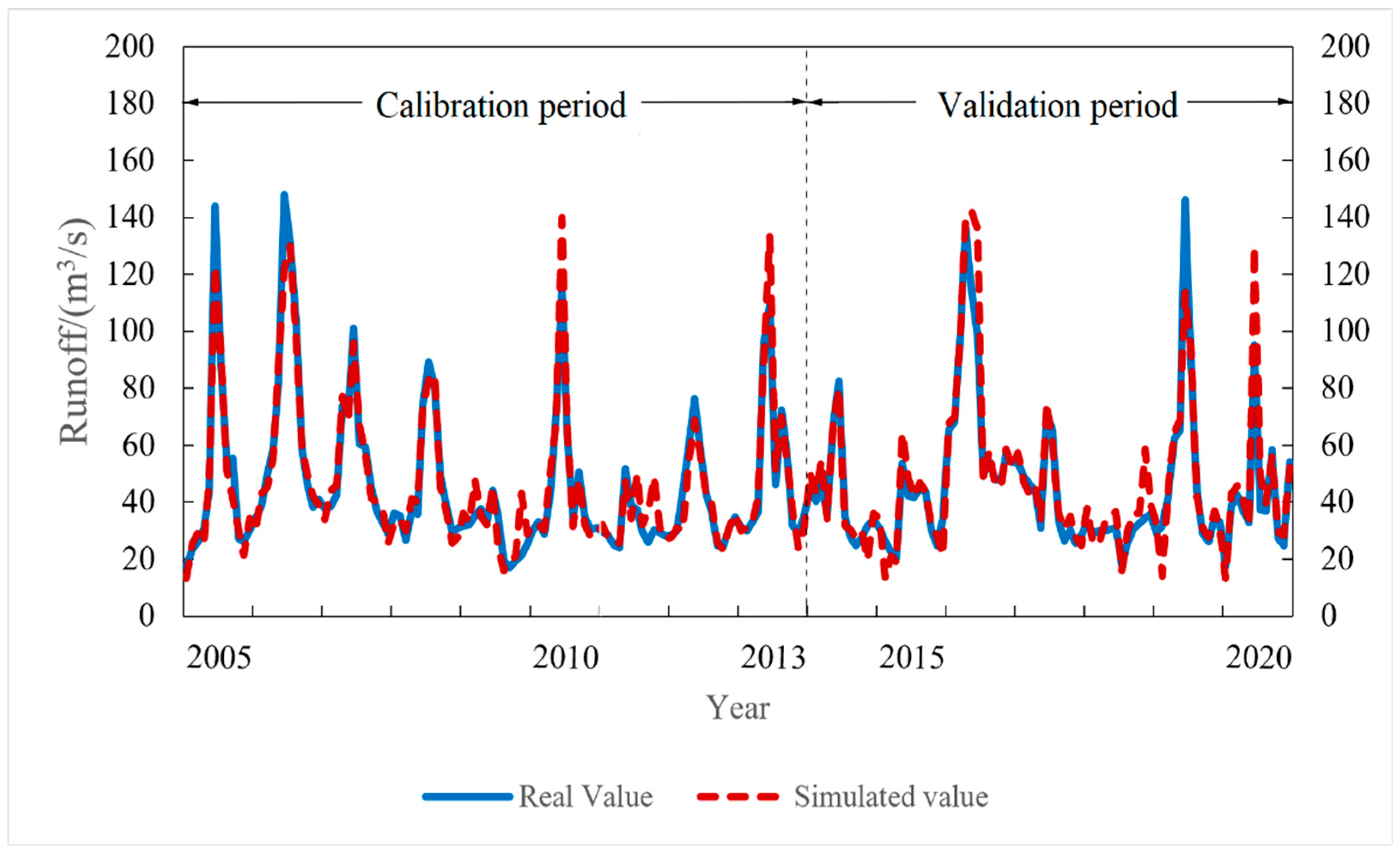
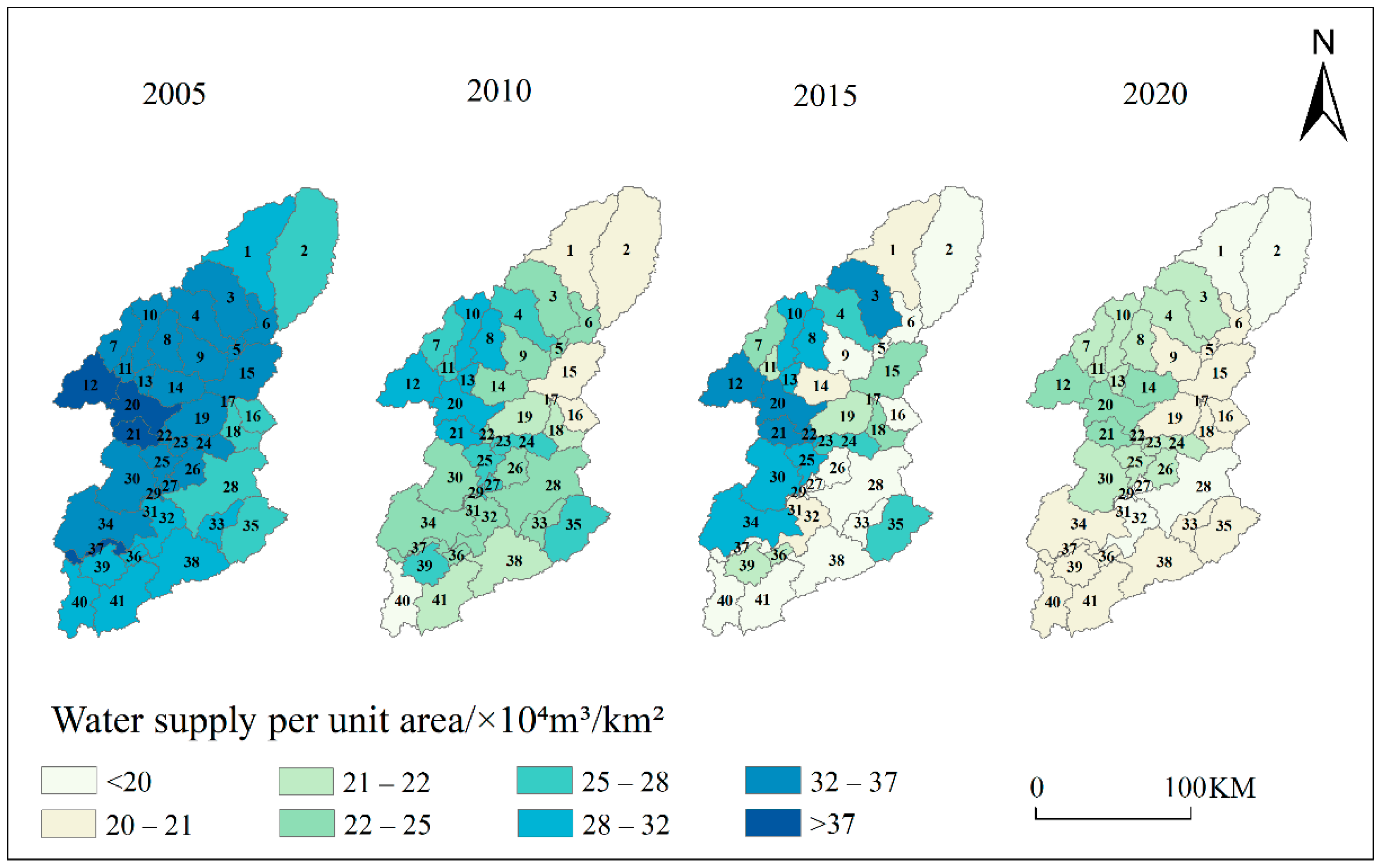
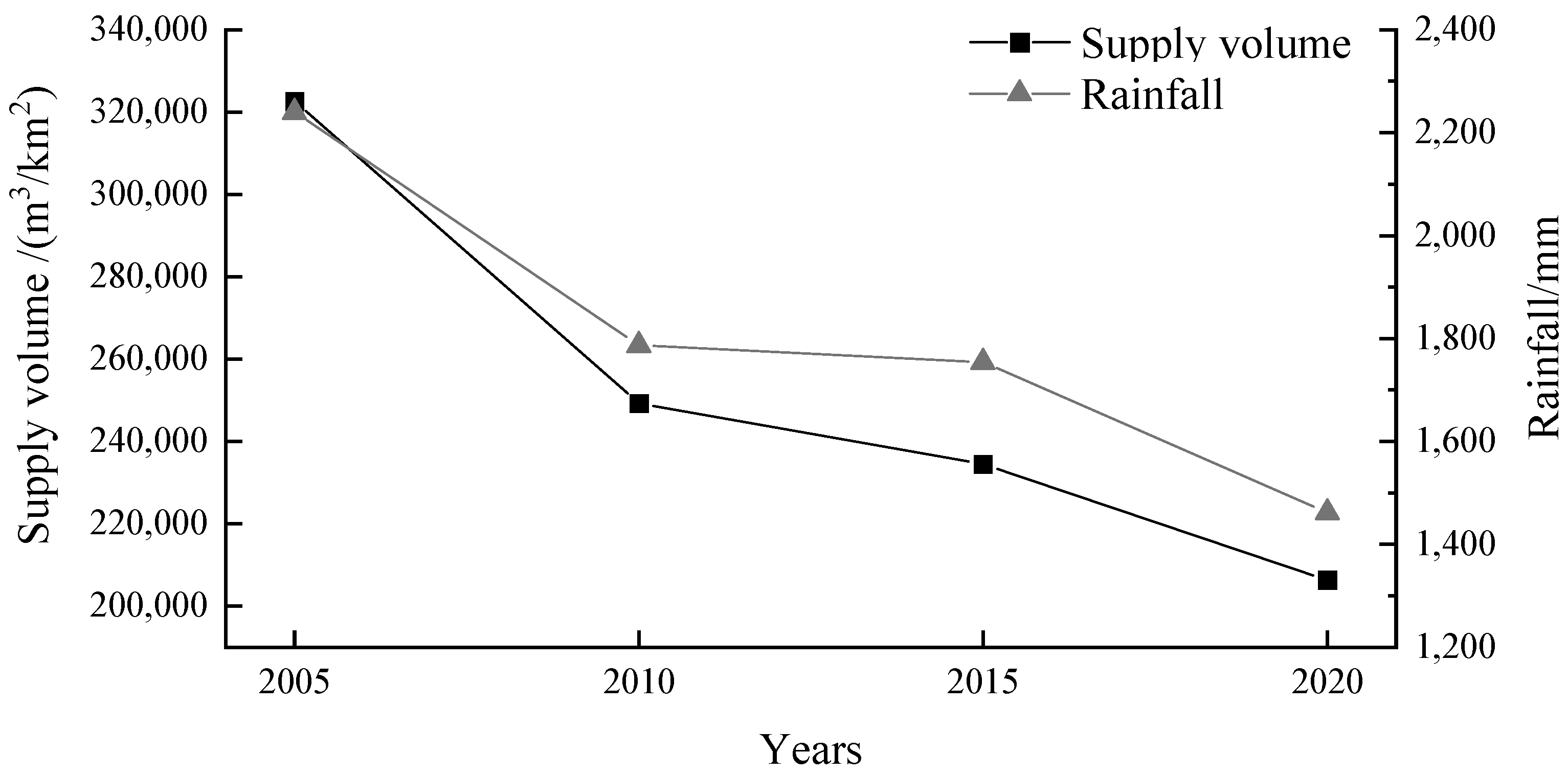

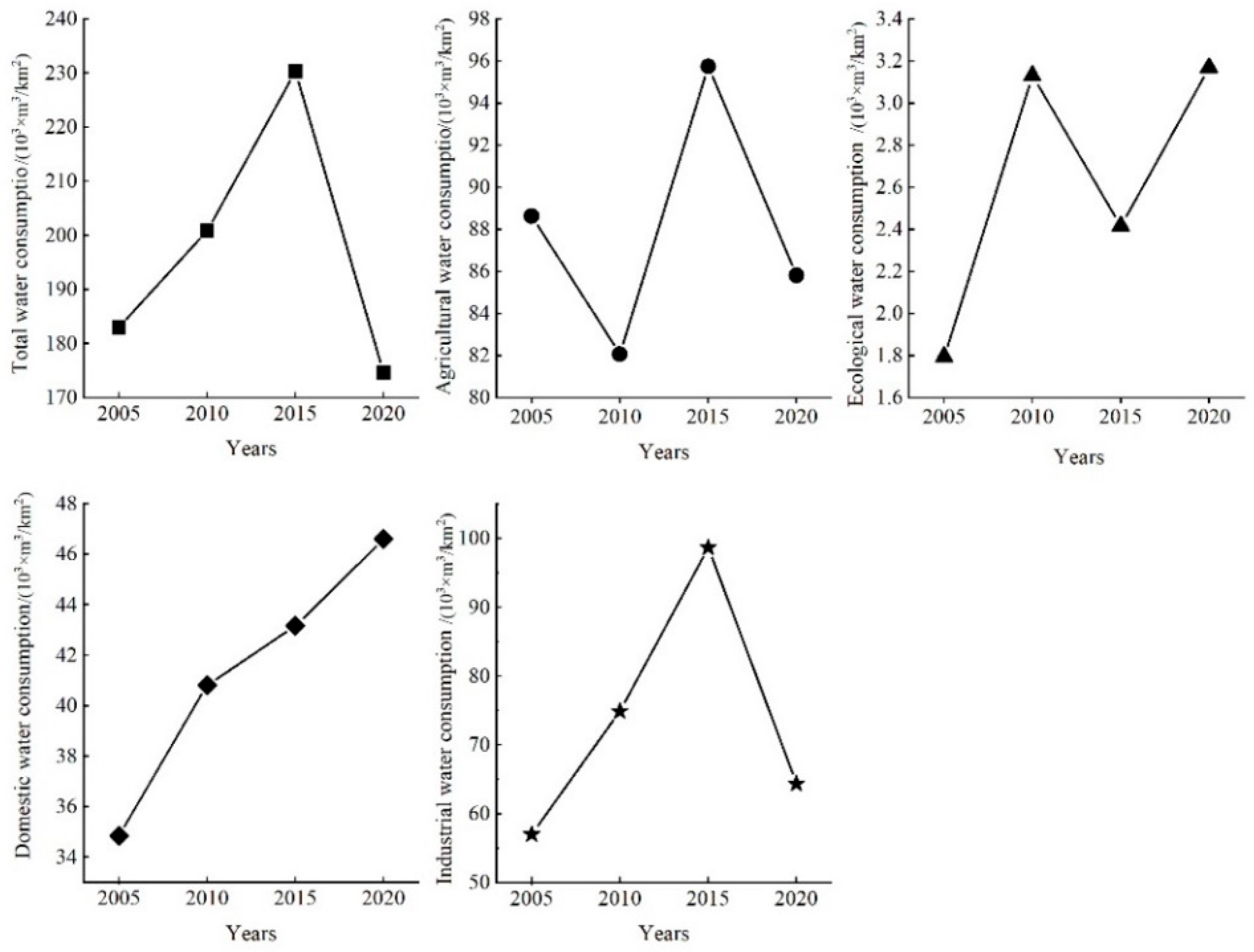

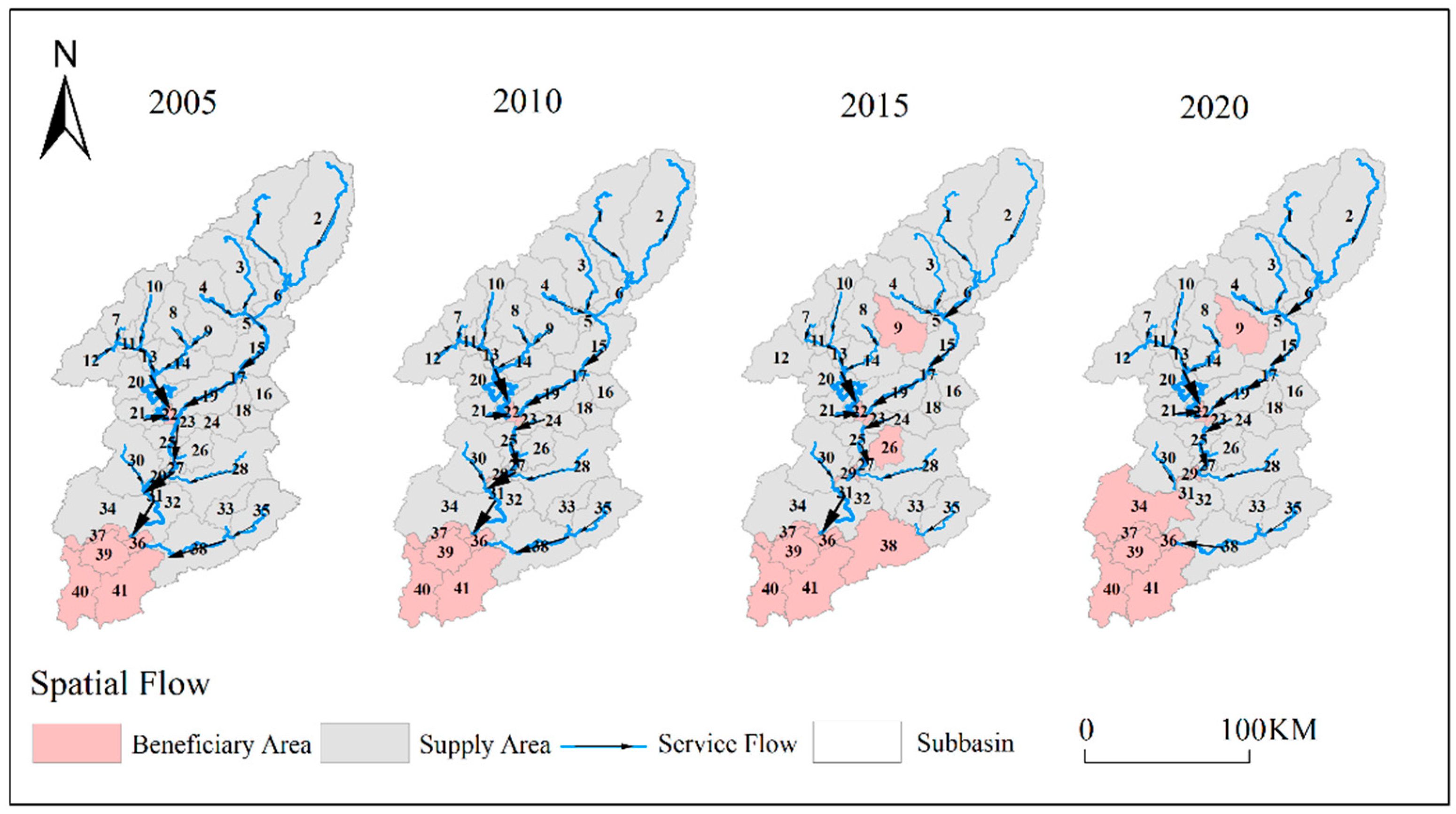

| Data Type | Data Description | Data Source |
|---|---|---|
| DEM data | Resolution 30 m | Geospatial data (https://www.gscloud.cn) accessed on 5 August 2019 |
| Land use data | Resolution 30 m | Center for Resources and Environment, Chinese Academy of Sciences (http://www.resdc.cn) accessed on 1 January 2019 |
| Soil data | Resolution 1000 m | National Earth System Science Data (http://www.geodata.cn) accessed on 1 March 2009 |
| Meteorological data | Rainfall data for 11 stations | China Weather Data Network (http://data.cma.cn) accessed on 4 August 2012 |
| Atmospheric Assimilation Drive Dataset for China [23] | CMADS official website (http://www.cmads.org) accessed on 31 December 2018 | |
| Hydrological data | Runoff data of Heyuan and Pingshan from 2005–2019 | Hydrological Yearbook (http://www.cmads.org) accessed on 31 December 2019 |
| Socioeconomic data | GDP data, water demand data | Statistical Yearbook and Water Resources Bulletin of Guangdong Province and Jiangxi Province (http://www.cmads.org) accessed on 8 October 2021 |
| Method of Transfer Change Type | Parameter Name Parameter | Parameter Definition Description | Global Sensitivity Analysis | Range of Values Value Range | Optimal Value | |
|---|---|---|---|---|---|---|
| t-Value | p-Value | |||||
| R | CN2 | Runoff curve coefficient | −2.186 | 0.273 | [−0.2,0.2] | 0.053 |
| V | ALPHA_BF | Baseflow regression coefficient | 1.552 | 0.364 | [0,1] | 0.833 |
| V | GW_DELAY | Groundwater delay days | −1.067 | 0.479 | [30,450] | 324 |
| V | GWQMN | Shallow groundwater runoff coefficient | 0.751 | 0.590 | [0,2] | 1.667 |
| V | GW_REVAP | Groundwater re-evaporation coefficient | 0.751 | 0.590 | [0,0.2] | 0.020 |
| V | ESCO | Soil evaporation compensation factor | 0.447 | 0.732 | [0.8,1] | 0.807 |
| V | CH_N2 | Main River Manning Factor | −1.589 | 0.358 | [0,0.3] | 0.130 |
| V | CH_K2 | Effective hydraulic conductivity of the river | 0.248 | 0.845 | [5,130] | 109.167 |
| V | ALPHA_BNK | The alpha factor of riparian storage | 0.456 | 0.728 | [0,1] | 0.100 |
| R | SOL_AWC | Effective water available to the soil | 1.499 | 0.375 | [−0.2,0.4] | 0.380 |
| R | SOL_K | Saturated hydraulic conductivity | 0.907 | 0.531 | [−0.8,0.8] | 0.640 |
| R | SOL_BD | Soil wet capacity | −3.188 | 0.194 | [−0.5,0.6] | 0.270 |
Publisher’s Note: MDPI stays neutral with regard to jurisdictional claims in published maps and institutional affiliations. |
© 2022 by the authors. Licensee MDPI, Basel, Switzerland. This article is an open access article distributed under the terms and conditions of the Creative Commons Attribution (CC BY) license (https://creativecommons.org/licenses/by/4.0/).
Share and Cite
Wang, X.; Zhang, Z.; Liu, F.; Chen, S.; Dong, J.; Mao, Y.; Cao, J. Study on Supply–Demand Balance Analysis and Service Flow of Water Resources in Dongjiang River Basin. Water 2022, 14, 2060. https://doi.org/10.3390/w14132060
Wang X, Zhang Z, Liu F, Chen S, Dong J, Mao Y, Cao J. Study on Supply–Demand Balance Analysis and Service Flow of Water Resources in Dongjiang River Basin. Water. 2022; 14(13):2060. https://doi.org/10.3390/w14132060
Chicago/Turabian StyleWang, Xinyi, Zhengdong Zhang, Fangrui Liu, Songjia Chen, Jianbin Dong, Yuanyuan Mao, and Jun Cao. 2022. "Study on Supply–Demand Balance Analysis and Service Flow of Water Resources in Dongjiang River Basin" Water 14, no. 13: 2060. https://doi.org/10.3390/w14132060
APA StyleWang, X., Zhang, Z., Liu, F., Chen, S., Dong, J., Mao, Y., & Cao, J. (2022). Study on Supply–Demand Balance Analysis and Service Flow of Water Resources in Dongjiang River Basin. Water, 14(13), 2060. https://doi.org/10.3390/w14132060





